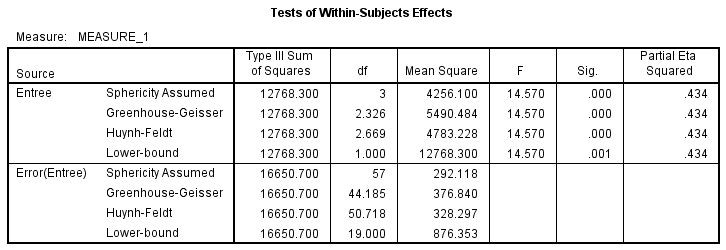The manager at a local restaurant suspects that the pasta dish served at her restaurant is much more enjoyable than the chicken, beef, and fish dishes. She offers four free entrées to 20 people in exchange for participating in her study. In order to minimize individual differences, she has each participant visit her restaurant four times; she randomly assigns them to have either chicken, beef, fish, or pasta on the first visit, another dish on their second visit, and so on. After each dish, they rate their enjoyment of the meal on a 100-point scale. Here is part of her SPSS output: Is it necessary for her to report effect size, and why?

a. No, because there is not a significant effect of entrée.
b. Yes, because we need to know how meaningful the effect of entrée is.
c. No, because the standard deviations are so small.
d. Yes, because p > .05.
Ans: B
You might also like to view...
Categories allow us to:
a. evolve new forms of language b. form associations between stimuli c. understand the past d. infer the invisible properties of objects
Some research has provided support for the notion that there is a general factor of intelligence, but other investigations have suggested that intelligence consists of distinct abilities. These discrepant results were first resolved by proposing
a. information processing approaches. c. Piaget's theory of cognitive development. b. hierarchical theories of intelligence. d. Vygotsky's zone of proximal development.
Which of the following statements is TRUE regarding the studies of girls who were exposed to androgens before birth?
A. When the girls grew up, they became more typically "female" in their desire for marriage and motherhood. B. The girls were found to prefer feminine activities during early childhood. C. The majority of the girls grew up to be lesbians. D. There were no noticeable effects of the androgen exposure.
Define frustration, compare the two sources of frustration, and list five common reactions to frustration
What will be an ideal response?